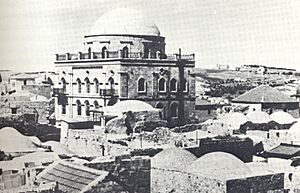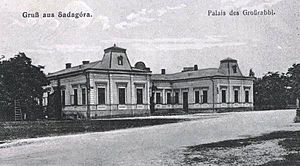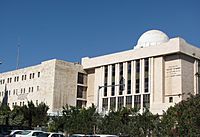Yisrael Friedman of Ruzhin facts for kids
Quick facts for kids Yisrael Friedman of Ruzhin |
|
|---|---|
| Ruzhiner Rebbe | |
| Signature |  |
| Born | October 5, 1796 Pohrebyshche, Russian Empire |
| Died | October 9, 1850 (aged 54) Sadigura, then Austria |
| Buried | Sadigura |
| Dynasty | Ruzhin |
| Father | Rabbi Sholom Shachne |
| Mother | Chava |
Israel Friedman of Ruzhyn (Hebrew: ישראל פרידמן מרוז'ין) (October 5, 1796 – October 9, 1850), also known as Israel Ruzhin, was a very important Hasidic leader, called a rebbe, in the 1800s. He lived in Ukraine and Austria. People called him Der Heiliger Ruzhiner, which means "The holy one from Ruzhyn". He was known for leading his community with great style and luxury, like a king.
Some say that Tsar Nicholas I of Russia, the ruler of Russia, was jealous of the Rebbe's wealth and influence. Because of this, the Tsar had the Rebbe put in prison for almost two years based on false accusations. After he was set free, the Rebbe went to Austria. There, he started his community again in Sadigura, a town in Bukovina near the Carpathian Mountains. Thousands of his followers, called Hasidim, came to join him. He also helped the Hasidic community in Israel and started building the Tiferet Yisrael Synagogue in the Old City of Jerusalem.
Israel Friedman was the first and only Ruzhiner Rebbe. However, his sons and grandsons later started their own Hasidic groups. These groups are all part of the "House of Ruzhin" and follow many of his traditions. Some of these groups include Bohush, Boyan, Chortkov, Husiatyn, Sadigura, and Shtefanesht. Other Hasidic groups, like Vizhnitz, Skver, and Vasloi, are connected to the Ruzhiner Rebbe through his daughters.
Contents
Early Life and Family History
Israel Friedman was born into a very special family. He was a direct descendant of Rabbi Dov Ber of Mezeritch, who was a main student of the Baal Shem Tov. The Baal Shem Tov was the founder of the Hasidic movement. Israel's great-grandfather was the Maggid of Mezritch, and his grandfather was Rabbi Avrohom HaMalach. His father was Sholom Shachne, who was a Rebbe in Prohobisht. His mother's father was Rabbi Nochum of Chernobyl, who was also close to the Baal Shem Tov. Israel was named Yisroel (Israel) after the Baal Shem Tov. He had two older brothers, Avrohom and Dov Ber, and a younger sister, Chaya Ita.
His family claimed to be descendants of the Royal line of King David. His father, the Rebbe of Prohobisht, lived differently from other Hasidic leaders. While most leaders wore simple white clothes, his father wore fancy woolen clothes with buttons. He also lived in a beautiful house with a big garden. Israel Friedman later adopted this grand style when he became a Rebbe.
Israel was only six years old when his father passed away. His older brother, Avrohom, who was 15, took over as the leader of their father's Hasidim. When Israel was seven, he became engaged to Sarah, the daughter of Rabbi Moses Efrati. At 13, he got married and moved to Botoșani, Romania. Three years later, his brother Avrohom died without children. Israel then became the leader of the Prohobisht Hasidim.
After living in Prohobisht and then in Skvyra, Israel Friedman settled in Ruzhyn. There, he became known as a very holy person and attracted thousands of followers. The Ruzhin dynasty grew to be the "largest and most important Hasidic community" in that part of the world. His leadership also helped the Hasidic movement become widely accepted. This allowed Hasidism to thrive in Ukraine and Volhynia for the next hundred years.
A Royal Court for God
The Ruzhiner Rebbe was a powerful leader known for his noble way of life. He created a royal atmosphere in his court. He lived in a grand palace with beautiful furniture. He rode in a fancy carriage with silver handles, pulled by four white horses. He was always surrounded by many helpers. He wore a golden yarmulke and stylish clothes with solid-gold buttons. His children also dressed like royalty and had servants.
This kind of grand lifestyle was very unusual for Hasidic leaders. However, many important rabbis and rebbes of his time accepted it. They believed that he was acting this way to bring honor to God through His representative, the tzadik (a very righteous person). His followers believed that the Ruzhiner Rebbe was always humble before God. They thought he made himself suffer with fasts and other difficult practices.
One winter night, after he stood outside to bless the New Moon, his followers saw blood on the snow where he had been standing. He was wearing his expensive gold boots with diamonds. They found out that the fancy boots had no soles, so the Rebbe was actually walking barefoot. After this, people understood that the Rebbe's grand lifestyle was only meant to honor Heaven.
A visitor once described Israel Friedman as someone who could not write well and struggled to sign his name. Hasidic stories confirm that the Rebbe was not highly educated in rabbinical studies. This might explain why he did not give long Torah speeches like other Hasidic masters. Instead, he preferred to tell simpler stories and parables. He even humbly called himself a "boor" (a rough person), saying, "I am a boor."
The visitor also noted that the Rebbe's face was smooth, with only a mustache. Some people thought this showed he was modern. Others believed it was because he had a bad skin disease when he was young, which left marks on his face.
The Rebbe treated poor and struggling people with the same respect as he treated famous rabbis and Hasidim who came to visit him. He also earned the respect of the Russian upper class.
Imprisonment and Escape
The Rebbe's fancy lifestyle and high status made Tsar Nicholas I jealous. It also angered the Jewish maskilim (members of the Jewish Enlightenment movement). These groups constantly tried to bring the Rebbe down. In 1838, the Rebbe was arrested. This happened during a two-year investigation into the murder of two Jewish informers. The governor-general of Berdichev accused the Rebbe of being involved in the murders.
He was brought before the Tsar. The Tsar's own agents told him that the Rebbe was trying to create his own kingdom and was against the government. The Tsar put the Rebbe in jail in Donevitz for seven months. Then, he was held alone in a prison in Kiev for fifteen months. They were deciding whether to send him away to the Caucasus or Siberia. No official charges were ever made against him, and he never had a trial.
On February 19, 1840, the Rebbe was suddenly released. However, he was still accused of being against the government. He was watched by the police at his home, which made it hard for his Hasidim to visit him. The Rebbe decided to move to Kishinev, where the local government was more understanding. His family joined him there.
His Hasidim found out that the Tsar still planned to send the Rebbe away for trying to create a "Jewish kingdom." So, they bribed the governor of Kishinev to give the Rebbe a special paper to leave for Moldavia. Just as the Rebbe was leaving Kishinev, the government orders to arrest and deport him arrived. When the Rebbe reached Iaşi, the capital of Moldavia, his Hasidim helped him get a pass to cross into Austria. Many Hasidim and other people across Eastern Europe asked government officials and even priests to help save the Rebbe from being sent away.
The Rebbe moved from town to town, including Shatsk in Bukovina (which was part of Austria), Kompling, and Skole. He finally settled in Sadigura, Bukovina. This town had the second-largest Jewish community in Austria. Forty years earlier, a 10-year-old boy named Yisroel Donenfeld had disappeared in Sadigura. The Rebbe claimed to be this long-lost Yisroel. With the help of eight men who said he was born in Sadigura, he received citizenship papers. His Hasidim helped him buy land in the town and show that he had enough money to support himself. Because of this, he became an honorary citizen and was protected by the Austrian government. In the summer of 1842, the Rebbe's family was finally allowed to join him. They had to agree not to visit or return to Russia.
The Rebbe built another grand home in Sadigura. It was even more beautiful than his old one in Ruzhyn. His beis medrash (synagogue) could hold 3,000 people. Thousands of Hasidim crossed the border from Galicia, Russia, and Romania to be with him. Soon, all the Jews in Sadigura became Ruzhiner Hasidim.
Helping the Community in Israel

The Apter Rav chose the Ruzhiner Rebbe to lead Kollel Volhynia. This group was in charge of collecting and giving out money to support the Hasidic community in the Land of Israel. The Rebbe encouraged Hasidim to move to Israel and helped support them through the kollel. He wanted to move to Israel himself, but he felt he could not leave his Hasidim.
In 1843, Rabbi Nissan Beck, a Ruzhiner Hasid, traveled from Jerusalem to Sadigura to see the Rebbe. He told the Rebbe that Tsar Nicholas I planned to buy land next to the Western Wall in Jerusalem. The Tsar wanted to build a church and monastery there. The Rebbe gave Beck the job of stopping the Tsar. Beck managed to buy the land from its Arab owners for a very high price. He did this just days before the Tsar ordered the Russian consul in Jerusalem to buy it. The Tsar had to buy a different piece of land for a church, which is now known as the Russian Compound.
The Rebbe's son, Rabbi Avrohom Yaakov Friedman of Sadigura, finished the work of raising money. He opened the new building in the summer of 1872. The synagogue was named Tiferet Yisroel after the Ruzhiner Rebbe. "Tiferet" means "glory." It was also known as the Nissan Beck Synagogue, named after its architect and builder.
The Rebbe passed away at 54 years old on October 9, 1850 (3 Cheshvan 5610). He likely died from heart failure and was buried in Sadigura. On his deathbed, he told his student, Rabbi Shneur Zalman: "The holy master, Rabbi Yehudah HaNasi, said he never enjoyed anything from this world, not even as much as a small finger. I promise, by Heaven and Earth, that I never enjoyed anything from this world, not even as much as a thin thread. My grand leadership and show of wealth were all done to honor God."
His burial place in Sadigura later became the resting place for two of his sons, Avraham Yaakov of Sadigura and Dov Ber of Leova, and other family members. It became a special place for Ruzhiner Hasidim to visit. His gravestone was destroyed during World War I but was later replaced with a large white concrete slab.
Family and Descendants
Israel Friedman and his first wife, Sarah, had six sons and four daughters. They were:
- Sholom Yosef (Sadigura): He led his father's Hasidim with his brothers for only a year until he died in 1851. His son, Rabbi Yitzchok, became the first Bohusher Rebbe.
- Avrohom Yaakov (Sadigura)
- Menachem Nochum (Shtefenesht)
- Dov Ber (Leova)
- Dovid Moshe (Chortkov)
- Mordechai Shraga (Husyatin)
- Chaya Malka: Her second marriage was to Rabbi Yitzchak Twersky, the first Rebbe of Skver.
- Gittel Tova: She married Yosef Monazon, who came from a rich banking family.
- Miriam: She married Rabbi Menachem Mendel Hager, the first Rebbe of Vizhnitz.
- Leah: She married Dovid Halpern, who also came from a wealthy banking family. Their son, Shalom Yosef, became the first Vasloi Rebbe in 1896.
Soon after his wife Sarah died in 1847, the Rebbe married Malka. She was the widow of Rabbi Tzvi Hirsch. Malka had a seven-year-old girl and a three-year-old boy from her first marriage. The Rebbe and Malka did not have any children together.
His Legacy and Influence
The Rebbe did not write any sefarim (religious books). However, his wise sayings and teachings have been written down by Ruzhiner Hasidim and people who wrote about his life.
Even today, many Ruzhiner places and organizations are named "Tiferet Yisroel" (Hebrew: תפארת ישראל), which means "Splendor of Israel." This name honors the Ruzhiner Rebbe. One example is the Mesivta Tiferet Yisroel, which is the Ruzhiner Yeshiva (a Jewish school) in Jerusalem. It was started in 1957 by the Rebbe's great-grandson, the Boyaner Rebbe of New York.
His Progeny
See also
 In Spanish: Yisroel Friedman de Ruzhin para niños
In Spanish: Yisroel Friedman de Ruzhin para niños
- Ruzhin (Hasidic dynasty)







